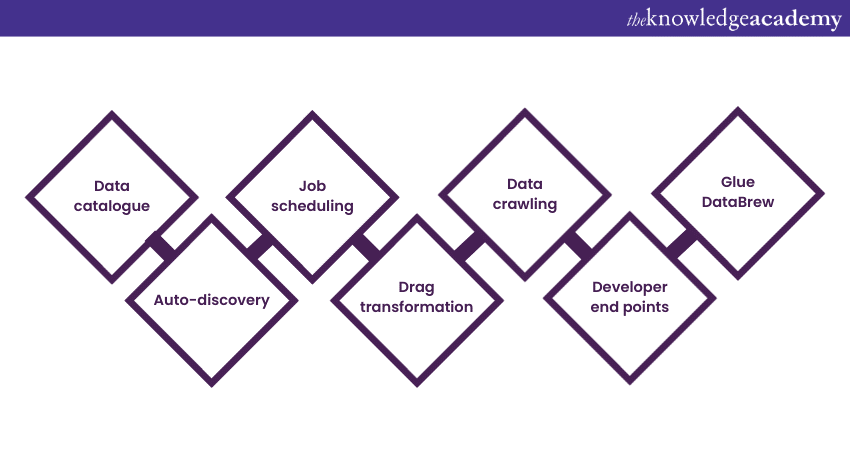We may not have the course you’re looking for. If you enquire or give us a call on 01344203999 and speak to our training experts, we may still be able to help with your training requirements.
We ensure quality, budget-alignment, and timely delivery by our expert instructors.

As information keeps growing on an everyday basis, many organisations are moving towards Cloud-based solutions to gather, keep, and operate on data. Additionally, the Extract, Transform, Load procedure (ETL) is important for transforming collected data from different sources into a common format that is acquired by Data Warehouses. That’s where AWS Glue plays an important role as an ETL tool.
Now, What is AWS Glue? AWS Glue is a fully managed ETL service that allows users to easily create and load their data for analytics. Want to learn more about AWS Glue and its importance in ETL procedure? If yes, you have landed on the right place. This blog will guide you through everything that you need to know on What is AWS Glue, its features, working process, benefits, and more.
Table of Contents
1) Understanding What is AWS Glue
2) Features of AWS Glue
3) How AWS Glue works?
4) Benefits of AWS Glue
5) Pricing of AWA Glue
6) Components of AWS Glue
7) Conclusion
Understanding What is AWS Glue?
AWS stands for Amazon Web Services which is a world’s leading Cloud services provider. AWS Glue is one of its significant products which provides serverless Cloud Computing services. AWS Glue is gaining more and more popularity as many businesses have started working on managing data integration services. Especially, Data engineers and ETL developers use AWS Glue for creating, running, and monitoring ETL workflows. To make the data integration procedure easier, AWS Glue provides both code and visual-based tools.
Amazon Glue is mainly formed with three components, namely AWS Glue Data Catalogue, a Configurable scheduler that deals with dependence resolutions, monitoring tasks or restarts, and an ETL engine that creates Scala code.
Enroll in our AWS Associate Solutions Architect Training and become a professional AWS Solutions Architect!
Features of AWS Glue

AWS offers a range of powerful features that make it a valuable tool for data integration and ETL tasks. Here are the following features you need to know.
1) Data catalogue: AWS Glue provides a centralised metadata repository that makes it easy to discover, manage and track data assets. This catalogue maintains information about data sources, transformations, and target locations.
2) Auto-discovery: AWS Glue can automatically discover and categorise data from various sources, including Amazon S3, Relational Databases and more. This saves time in understanding the structure and format of your data.
3) Job scheduling: AWS Glue can be used based on the schedule. With the help of AWS Glue, you can use a scheduler for creating ETL Pipelines sophisticatedly by setting up dependencies between tasks.
4) Drag transformation: AWS Glue enables you to apply a transformation to your data during the ETL process. You can clean, enrich, and reformat data using the built-in data transformation feature.
5) Data crawling: The data catalogue in AWS Glue supports automatic data crawling which scans your data sources to infer schema and update the catalogue with the latest metadata.
6) Developer endpoints: AWS Glue provides developer endpoints to enable you to change, debug and test the code if you want to actively create your ETL code.
7) Glue DataBrew: It is a data preparation tool for users like Data Scientists and Data Analysts. It helps them clean and normalise data with the help of Glue DataBrew’s active and visual interface.
How does AWS Glue work?
AWS Glue manages the complete data transfer and transformation with the help of other AWS services into Data Lakes like Data Warehouses, Amazon S3, etc. It takes an API’s assistance in extracting data from different sources and then transferring it to data integration jobs.
With the help of AWS Glue, one can set the events for the jobs or schedule the ETL jobs to start. According to the input given by the user, it creates code, then extracts all the data and transforms it. You can even modify the code in the scripts according to the requirements. Then, it writes the job’s metadata into the data catalogue, which is called the metadata repository.
AWS Glue offers a console management service that enables users to get notifications for each job and create and track ETL jobs.
To learn more about AWS, check out our AWS Technical Essentials Training!
Benefits of AWS Glue
There are several benefits that AWS Glue offers. Let’s look at some of the major ones:
1) Data integration: AWS Glue simplifies the process of discovering, cataloguing and transforming data from various sources. It supports both structured and semi structured data.
2) Serverless: AWS Glue is serverless, which means you do not have to manage infrastructure. It automatically provisions resources based on the workload, allowing you to focus on data processing and transformation.
3) Scalability: AWS Glue can scale automatically to handle varying workloads, ensuring that your data processing tasks are performed efficiently even as the volume of data grows.
4) Data security: AWS Glue offers data encryption in transit and at rest, along with integration with AWS Identity and Access Management (IAM) for access control.
5) Flexible job development: You can use either Glue’s visual ETL job editor or write custom code in languages like Python or Scala to perform complex transformations.
Pricing of AWS Glue
The starting price of Amazon Glue is GBP 0.36. There are four different plans available in AWS Glue:
1) ETL tasks and development endpoints are available at the price of GBP 0.36.
2) DataBrew and Crawlers interactive sessions are available at the price of GBP 0.36.
3) The starting price of a job at DataBrew is GBP 0.39.
4) The prices for monthly storage and data catalogue are GBP 0.36.
There are no free plans available for AWS Glue. For every hour, it will cost around GBP 0.36 per DPU. So, on average, it will cost around GBP 17.12 per day. However, prices may differ based on the region.
Components of AWS Glue
To create and maintain the ETL workflow, AWS Glue depends on the interaction of various components. Here are a few crucial components:
1) Crawlers: AWS Glue crawlers automatically discover catalogue metadata from various data sources such as databases, data lakes and other storage locations.
2) Classifier: A classifier is called a schema of your data that is firmed by the classifier. AWS Glue offers classifiers for several file types, such as JSON, CSV, XML, AVRO and more.
3) Connection: AWS Glue connection is described as an object of the data catalogue that contains the characteristics required for connection to a specific data storage.
4) Dynamic frames: AWS Glue dynamic frames are extensions of Apache Spark Data Frames that allow for more flexible handling of semi-structured data. They simplify the ETL process by providing a schema-read-on approach.
5) Data storage: Data storage is a place where you can keep your data for a long period of time. There are two examples of data storage, i.e. Amazon S3 and Relational Databases.
Enroll in our Developing Serverless Solutions on AWS Course and get familiar with AWS X
Conclusion
We hope that you found this blog useful. In this blog, we have discussed What is AWS Glue in great detail. Throughout this comprehensive blog, we have explored its rich array of features, working processes, benefits, pricing and components. AWS Glue empowers businesses to streamline their data Pipelines and unlock valuable insights from their data assets.
To Learn the five pillars of the Well-Architected Framework, check out our Advanced Architecting On AWS - Professional Certification Course!
Upcoming Cloud Computing Resources Batches & Dates
Date
 AWS RoboMaker Training
AWS RoboMaker Training
Fri 4th Apr 2025
Fri 6th Jun 2025
Fri 8th Aug 2025
Fri 3rd Oct 2025
Fri 5th Dec 2025






 Top Rated Course
Top Rated Course



 If you wish to make any changes to your course, please
If you wish to make any changes to your course, please


